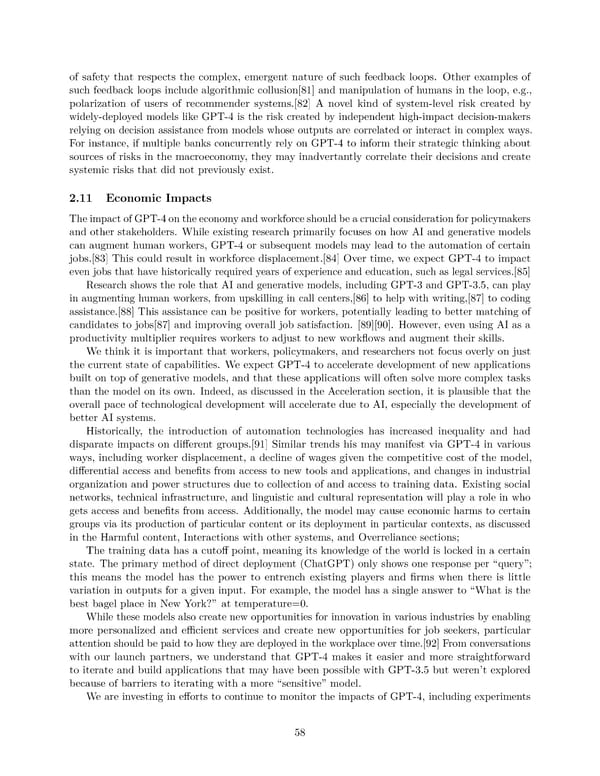of safety that respects the complex, emergent nature of such feedback loops. Other examples of such feedback loops include algorithmic collusion[81] and manipulation of humans in the loop, e.g., polarization of users of recommender systems.[82] A novel kind of system-level risk created by widely-deployed models like GPT-4 is the risk created by independent high-impact decision-makers relying on decision assistance from models whose outputs are correlated or interact in complex ways. For instance, if multiple banks concurrently rely on GPT-4 to inform their strategic thinking about sources of risks in the macroeconomy, they may inadvertantly correlate their decisions and create systemic risks that did not previously exist. 2.11 Economic Impacts TheimpactofGPT-4ontheeconomyandworkforceshouldbeacrucialconsiderationforpolicymakers and other stakeholders. While existing research primarily focuses on how AI and generative models can augment human workers, GPT-4 or subsequent models may lead to the automation of certain jobs.[83] This could result in workforce displacement.[84] Over time, we expect GPT-4 to impact even jobs that have historically required years of experience and education, such as legal services.[85] Research shows the role that AI and generative models, including GPT-3 and GPT-3.5, can play in augmenting human workers, from upskilling in call centers,[86] to help with writing,[87] to coding assistance.[88] This assistance can be positive for workers, potentially leading to better matching of candidates to jobs[87] and improving overall job satisfaction. [89][90]. However, even using AI as a productivity multiplier requires workers to adjust to new workflows and augment their skills. Wethink it is important that workers, policymakers, and researchers not focus overly on just the current state of capabilities. We expect GPT-4 to accelerate development of new applications built on top of generative models, and that these applications will often solve more complex tasks than the model on its own. Indeed, as discussed in the Acceleration section, it is plausible that the overall pace of technological development will accelerate due to AI, especially the development of better AI systems. Historically, the introduction of automation technologies has increased inequality and had disparate impacts on different groups.[91] Similar trends his may manifest via GPT-4 in various ways, including worker displacement, a decline of wages given the competitive cost of the model, differential access and benefits from access to new tools and applications, and changes in industrial organization and power structures due to collection of and access to training data. Existing social networks, technical infrastructure, and linguistic and cultural representation will play a role in who gets access and benefits from access. Additionally, the model may cause economic harms to certain groups via its production of particular content or its deployment in particular contexts, as discussed in the Harmful content, Interactions with other systems, and Overreliance sections; The training data has a cutoff point, meaning its knowledge of the world is locked in a certain state. The primary method of direct deployment (ChatGPT) only shows one response per “query”; this means the model has the power to entrench existing players and firms when there is little variation in outputs for a given input. For example, the model has a single answer to “What is the best bagel place in New York?” at temperature=0. While these models also create new opportunities for innovation in various industries by enabling more personalized and efficient services and create new opportunities for job seekers, particular attention should be paid to how they are deployed in the workplace over time.[92] From conversations with our launch partners, we understand that GPT-4 makes it easier and more straightforward to iterate and build applications that may have been possible with GPT-3.5 but weren’t explored because of barriers to iterating with a more “sensitive” model. Weare investing in efforts to continue to monitor the impacts of GPT-4, including experiments 58
 GPT-4 Page 17 Page 19
GPT-4 Page 17 Page 19